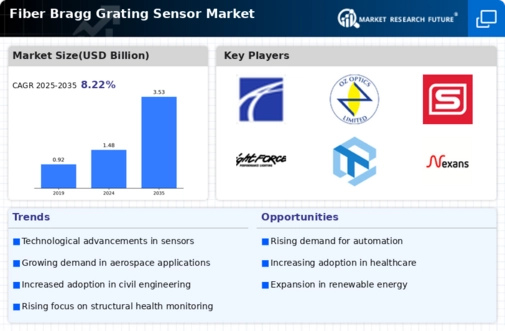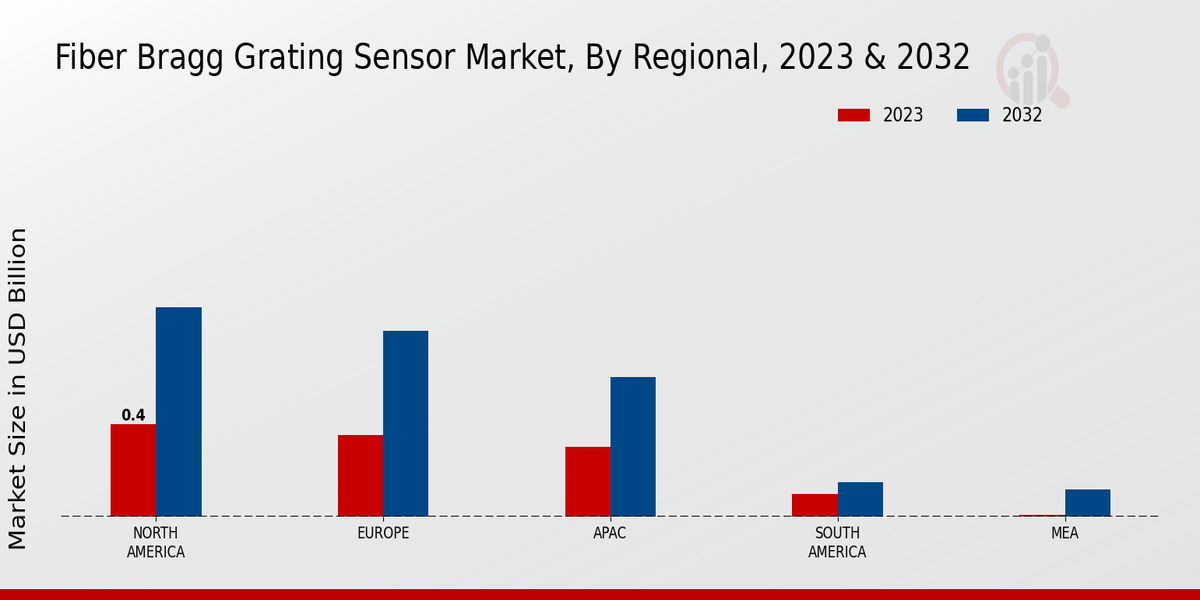Market Growth Projections
The Global Fiber Bragg Grating Sensor Market Industry is projected to experience substantial growth, with estimates indicating a market value of 1.48 USD Billion in 2024 and a potential increase to 3.53 USD Billion by 2035. This growth trajectory suggests a compound annual growth rate of 8.22% from 2025 to 2035, reflecting the increasing adoption of Fiber Bragg Grating sensors across various sectors. The expansion is driven by technological advancements, rising demand for monitoring solutions, and the integration of these sensors into emerging applications. As industries continue to recognize the benefits of Fiber Bragg Grating technology, the market is poised for significant expansion.
Advancements in Telecommunications
The Global Fiber Bragg Grating Sensor Market Industry benefits from advancements in telecommunications, particularly in fiber optic networks. Fiber Bragg Grating sensors are integral to enhancing signal quality and reducing losses in optical fibers. With the increasing demand for high-speed internet and data transmission, these sensors play a crucial role in optimizing network performance. The expansion of 5G technology further propels the adoption of Fiber Bragg Grating sensors, as they are essential for managing the complexities of modern communication systems. This trend is expected to contribute to the market's growth, with projections indicating a rise to 3.53 USD Billion by 2035.
Growing Adoption in Medical Applications
The Global Fiber Bragg Grating Sensor Market Industry sees a growing adoption of these sensors in medical applications, particularly in biomedical sensing and monitoring. Their ability to provide precise measurements of temperature, pressure, and strain makes them invaluable in medical devices and surgical instruments. For example, Fiber Bragg Grating sensors are utilized in minimally invasive surgeries, where real-time feedback is critical for patient safety. As the healthcare sector increasingly embraces innovative technologies, the market for these sensors is expected to expand, driven by the need for enhanced patient monitoring and diagnostic capabilities.
Regulatory Support for Smart Infrastructure
The Global Fiber Bragg Grating Sensor Market Industry benefits from regulatory support aimed at promoting smart infrastructure initiatives. Governments worldwide are implementing policies that encourage the integration of advanced monitoring technologies in public infrastructure projects. This regulatory environment fosters the adoption of Fiber Bragg Grating sensors, which are essential for ensuring safety and efficiency in smart cities. As urbanization continues to rise, the demand for intelligent monitoring solutions is expected to increase, driving market growth. The emphasis on sustainable development and smart infrastructure is likely to create new opportunities for Fiber Bragg Grating sensor applications.
Rising Demand for Structural Health Monitoring
The Global Fiber Bragg Grating Sensor Market Industry experiences a notable surge in demand for structural health monitoring systems across various sectors, including civil engineering and aerospace. These sensors provide real-time data on structural integrity, enabling timely maintenance and reducing the risk of catastrophic failures. For instance, the integration of Fiber Bragg Grating sensors in bridges and buildings allows for continuous monitoring, which is crucial for safety and longevity. As infrastructure investments increase globally, the market is projected to grow significantly, with a valuation of 1.48 USD Billion in 2024, reflecting a growing reliance on advanced monitoring technologies.
Increased Investment in Research and Development
The Global Fiber Bragg Grating Sensor Market Industry is witnessing increased investment in research and development, fostering innovation and the introduction of new applications. Governments and private entities are funding projects aimed at exploring the capabilities of Fiber Bragg Grating sensors in various fields, including environmental monitoring and industrial automation. This commitment to R&D is likely to yield advanced sensor technologies that enhance performance and broaden application scopes. As a result, the market is projected to grow at a compound annual growth rate of 8.22% from 2025 to 2035, reflecting the potential for new breakthroughs and expanded market reach.








